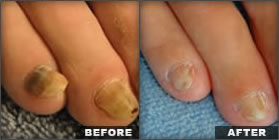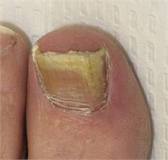Posts Tagged ‘toenail fungal infection’
How Can I Permanently Cure My Toenail Fungus?
How Can I Permanently Cure My Toenail Fungus?
 Doctors tend to shy away from the word “cure” when referring to toenail fungus because it is not an easy thing to do. We have become a very busy society that believes popping a pill will take care of everything. Unfortunately that is not the case with toenail fungus. Onychomycosis, the medical term for toenail fungus is hard to cure because the treatment regimen is very long and can be quite involved. Most kinds of fungus are able to lie dormant for a long period so people will go through treatment and get positive results, only to find that the infection returns. Curing toenail fungus permanently is a possibility, it just take work and patience.
Doctors tend to shy away from the word “cure” when referring to toenail fungus because it is not an easy thing to do. We have become a very busy society that believes popping a pill will take care of everything. Unfortunately that is not the case with toenail fungus. Onychomycosis, the medical term for toenail fungus is hard to cure because the treatment regimen is very long and can be quite involved. Most kinds of fungus are able to lie dormant for a long period so people will go through treatment and get positive results, only to find that the infection returns. Curing toenail fungus permanently is a possibility, it just take work and patience.
Several factors must be taken into account when examining your chances of curing toenail fungus. First is how far along your toenail fungal infection is. If you can catch it early, you stand a better chance of eliminating it entirely. As a fungal infection progresses, it goes from the skin surrounding the toenail into and under the toenail, where it becomes much harder to eradicate. Second is your own level of commitment. Treating toenail fungus is much more involved than just taking a pill. The idea is to create a hostile environment for the fungus so that they die off. This may involve washing your feet several times a day with a special soap and then donning clean socks each time. Yes, this is a lot of work (and extra laundry) but if you wish to control and end the toenail fungal infection, you will need to follow all of your doctor’s instructions as well as educate yourself on how to avoid recurrence.
The most unfortunate part about curing toenail fungus is that the statistics are so out of whack on actual success because so many people get frustrated part way through their cure and give up, or they miss a day or two and get pushed back by two weeks. This negates the outcome of the studies that have been done, or at least makes the conclusion “unknown”. If you are going to treat your toenail fungus, you need to address all of the problems and be willing to put in the time and effort it will take to achieve a successful result.
Oral prescription medication
If you and your doctor decide that the oral prescription medication is the way to go, ask about helping the process along by using a natural topical antifungal like Tea Tree Oil as part of your healing regimen. Giving your body help from both the inside and the outside can work in your favor. The goal behind combining your efforts is to permanently eradicate the fungi living off of you. This combination of efforts will take effort on your part in maintaining a healthy for you/not healthy for the fungus environment.
The biggest barrier to a cure for toenail fungus for most people is the amount of time and work that go into treatment of this disease. Washing your feet and applying medication 2-3 times a day as well as doing extra laundry to make sure your socks are clean and finding shoes that allow your feet to breath will become stressful. You must remember that missing one day of treatment will undo the last four you worked so hard on as it only takes the fungus one day to re-establish themselves. If you can stick to the program, with the help of your doctor, you can permanently end your toenail fungus problem.
So How Do I Tell if My Toenail is Infected With a Fungus?
So How Do I Tell if My Toenail
is Infected With a Fungus?
 Having a nail that is infected with a fungus is not all that uncommon as it affects 10-12% of the American population. A toenail fungal infection is caused by microorganisms that lodge in the tiny cracks in the skin around the toenails. As the foot usually lives in a dark, damp environment, this is an ideal growing medium for the fungal spores. The symptoms of a fungal toenail infection are fairly consistent and if you know what to look for it is easier to catch it early on.
Having a nail that is infected with a fungus is not all that uncommon as it affects 10-12% of the American population. A toenail fungal infection is caused by microorganisms that lodge in the tiny cracks in the skin around the toenails. As the foot usually lives in a dark, damp environment, this is an ideal growing medium for the fungal spores. The symptoms of a fungal toenail infection are fairly consistent and if you know what to look for it is easier to catch it early on.
The first symptom to show up is usually a white or yellowish spot on the toenail. This may be a minute object, which makes it harder to recognize. This spot is the beginnings of the infection and will gradually grow to cover more of the nail. As most people don’t suffer any discomfort and with the advent of wearing nail polish, many people don’t even notice this minor change.
As the infection continues, the small spot will increase and cover the entire toenail. The toenail will become dull, yellowed and even change shape. Some people see a dark spot either where the infection began or around the edges of the toenail, though this happens more frequently with severe cases. At some point, the nail may become disconnected from the nail bed.
Nail becoming yellow and thick?
The process of the nail becoming yellow and thick is a classic toenail fungus symptom. Also common is flaking or crumbling of the toenail, which again occurs in the severe cases of the disease.
The only way to determine whether your symptoms are that of a toenail fungal infection or are the result of something that mimics these symptoms is to see your doctor. At that point your doctor will be able to ask you some questions and take a sample of your toenail to be examined under a microscope and/or cultured. Be sure to tell your doctor if you have spent time in a public pool or spa lately as this may increase your chances of contracting a toenail fungus infection.
Ask the doctor
Once your doctor has been given the chance to examine and sample your toenail, a solution will be able to be found that will be most effective for you. This will help your doctor determine which medication will be best for your particular infection. Toenail funguses are notoriously difficult to treat and cure, so allowing your doctor to get all the pertinent information will help you both to make an informed decision. One of the problems with nail funguses is that they all tend to display the same symptoms but that doesn’t mean they require the same treatment. And there are other conditions that will mimic the standard symptoms of a nail fungus, so working with your doctor to come up with the best treatment is in everybody’s interest.